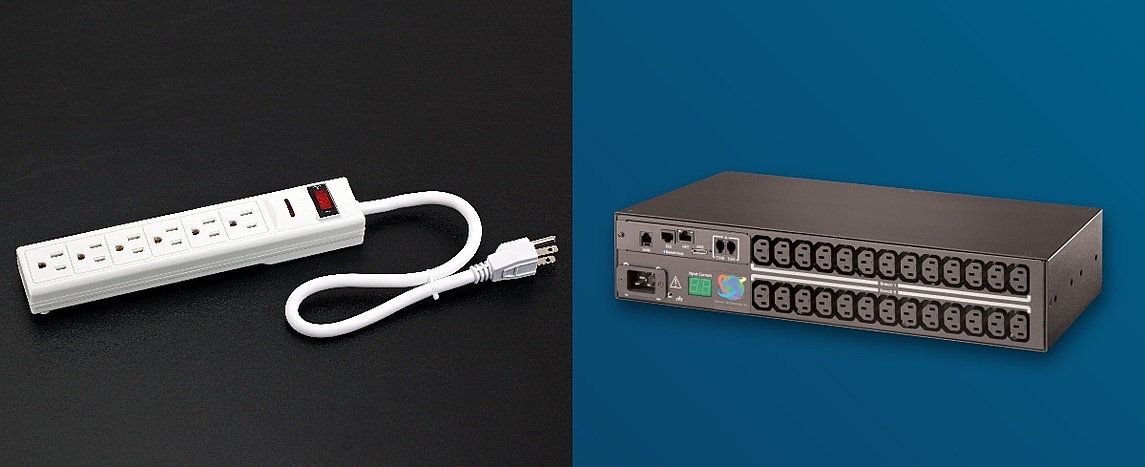Using a consumer power strip in your server rack? It's time to upgrade.
RJ Tee
November 29, 2016
- Categories:
- Tags:

Recently, a customer wondered about the real difference between high-quality power distribution units (PDUs) for the data center, and standard 120V power outlets (like the kind you would find in Home Depot). Why spend the extra money? They both supply power directly to the cabinet, right?
In short, yes—they do. The products, however, are in separate classes in terms of what they are capable of providing. Think of it this way: A power outlet is to a power distribution unit like a flip phone is to a smartphone; the former is very basic, while the latter is much more powerful and complex.
A standard power outlet, in other words, offers 120V of alternating current (AC), seven outlets, and, in some cases, surge protection. Conversely, Server Technology’s most basic rack PDU offers up to 230V AC and up to 26 outlets in a slimmer, more compact device that is specifically engineered for use in a high-performance data center. On the other end of the spectrum, Server Technology’s advanced PDUs can provide up to 42 outlets in a single unit, with up to 415V AC, advanced network cards, power measurement technology, temp and humidity probes, and the list goes on...
It’s important to note that Server Technology has several different — and highly customizable — products in its PDU family. In addition to the aforementioned basic PDU, there are also metered, smart, switched, smart POPS (Per Outlet Power Sensing) and switched POPS PDUs.
Here is a look at some of the advanced capabilities of Server Technology’s PDUs:
Remote switching (for switched PDUs and switched POPS): To toggle power on and off with a standard PDU, you need to be standing right next to it. Server Technology’s PDUs enable individual outlet control for remotely switching power on and off. This feature is ideal for large data centers that have hundreds of different cabinets, or those with multiple facilities spread out across the world. Authorized users can use remote switching to control power flows without having to be physically present.
Input current monitoring (for metered, smart, switched, smart POPS, and switched POPS): The vast majority of power usage in a data center comes from cabinets, where servers run all day and all night, week in and week out. Many servers, for that matter, run even when they are not being used, which wastes electricity and money. When using basic power outlets, there is no way to tell how much electricity is being used in each cabinet on a daily basis. Server Technology’s input current monitoring feature allows managers to see power usage for individual circuits, which is helpful for identifying which devices can be scaled back or eliminated to reduce waste.
Secure access (for smart, switched, smart POPS, and switched POPS): With the ability to monitor input current comes the great responsibility to protect this information from hackers or unauthorized users. Server Technology’s PDUs come with strong access, security, and communications control so that only authorized users can access power usage data and make critical changes to the network.
Greater cable retention (for all PDUs): In a standard power outlet, cables can easily become dislodged, which can lead to unexpected power outages. Server Technology offers PDUs that come with lockable, high-retention outlets to ensure that cables stay firmly in place.
Environmental monitoring (for smart, switched, smart POPS, and switched POPS): A standard power outlet won’t do much to prevent environmental disasters. That’s because power outlets don’t contain advanced sensors for measuring temperature and humidity levels. Server Technology’s PDUs do contain such sensors, which can transmit critical environmental alerts when cabinets exceed customizable environmental thresholds. This allows managers to prevent equipment from overheating and breaking. What’s more, all Server Technology PDUs are designed for use in higher temperatures, which means they come with less inherent risk.
Alternating phase distribution (for 3-phase PDUs): Load balancing is a necessary — also difficult and time-consuming — task that must be performed manually on standard power outlets. Server Technology’s PDUs streamline load balancing with a new, unique method called alternating phase power distribution. The result is a simpler and more efficient process.
Flexible mounting (for all PDUs): Standard power outlets rest on the floor, where they get kicked around and abused. Server Technology’s PDUs are slim and flexible enough to mount directly inside or on top of a cabinet, where they take up less room.
Thanks for your submission. One of our Power Strategy Experts will get back to you shortly.